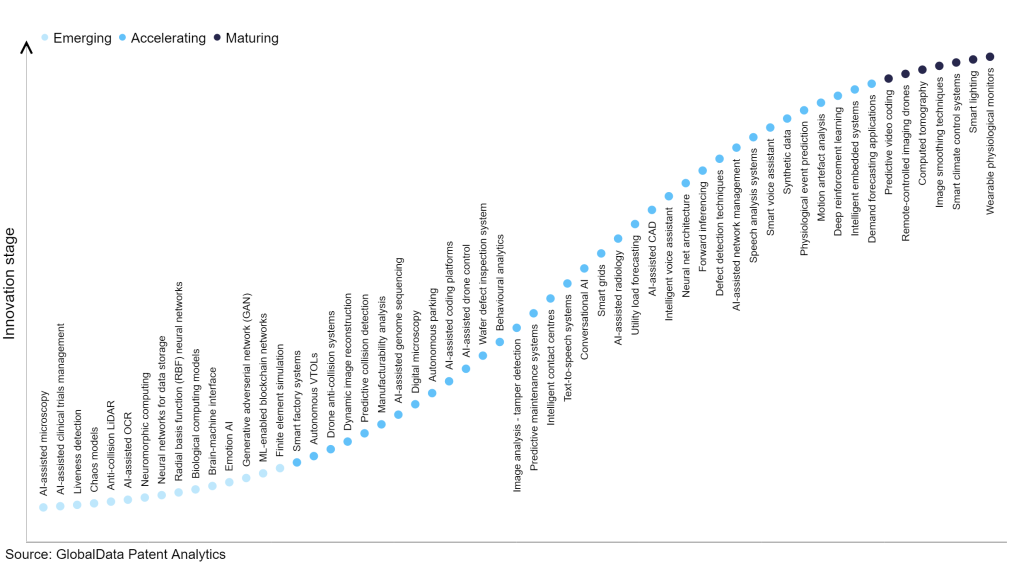The technology industry continues to be a hotbed of innovation, with activity driven by increasing demand for personalised healthcare, the rising prevalence of chronic diseases, and the growing adoption of wearable technology. This has resulted in the growing importance of technologies such as machine learning (ML), deep learning, and data analytics. In the last three years alone, there have been over 3.6 million patents filed and granted in the technology industry, according to GlobalData’s report on Innovation in Artificial Intelligence: Wearable physiological monitors. Buy the report here.

Access deeper industry intelligence
Experience unmatched clarity with a single platform that combines unique data, AI, and human expertise.
However, not all innovations are equal and nor do they follow a constant upward trend. Instead, their evolution takes the form of an S-shaped curve that reflects their typical lifecycle from early emergence to accelerating adoption, before finally stabilising and reaching maturity.
Identifying where a particular innovation is on this journey, especially those that are in the emerging and accelerating stages, is essential for understanding their current level of adoption and the likely future trajectory and impact they will have.
300+ innovations will shape the technology industry
According to GlobalData’s Technology Foresights, which plots the S-curve for the technology industry using innovation intensity models built on over 2.5 million patents, there are 300+ innovation areas that will shape the future of the industry.
Within the emerging innovation stage, finite element simulation, generative adversarial networks (GAN), and ML-enabled blockchain networks are disruptive technologies that are in the early stages of application and should be tracked closely. Demand forecasting applications, intelligent embedded systems, and deep reinforcement learning are some of the accelerating innovation areas, where adoption has been steadily increasing. Among maturing innovation areas are smart lighting and wearable physiological monitors, which are now well established in the industry.
Innovation S-curve for artificial intelligence in the technology industry

Wearable physiological monitors is a key innovation area in artificial intelligence
Wearable physiological monitors are wearable devices that track and record vital signs such as heart rate, blood pressure, respiratory rate, body temperature, and other health-related data. These devices are commonly employed for health monitoring and diagnostic purposes, providing valuable insights into an individual's well-being.
GlobalData’s analysis also uncovers the companies at the forefront of each innovation area and assesses the potential reach and impact of their patenting activity across different applications and geographies. According to GlobalData, there are 130+ companies, spanning technology vendors, established technology companies, and up-and-coming start-ups engaged in the development and application of wearable physiological monitors.
Key players in wearable physiological monitors – a disruptive innovation in the technology industry
‘Application diversity’ measures the number of different applications identified for each relevant patent and broadly splits companies into either ‘niche’ or ‘diversified’ innovators.
‘Geographic reach’ refers to the number of different countries each relevant patent is registered in and reflects the breadth of geographic application intended, ranging from ‘global’ to ‘local’.
Samsung is a leading patent filer in the wireless microphones space. One of the company’s patents describes wearable electronic device that includes sensors, a communication module, a touchscreen display, a battery module, memory, and a processor. The device is capable of obtaining heart rate and motion information from the user, as well as monitoring the battery power. Based on this information, the device can control the operation of the touchscreen display and communication module, including turning on or turning off the Wi-Fi module. Additionally, the touchscreen display can be deactivated if the user's motion indicates significant movement. The sensors mentioned include heartbeat, acceleration, gyro, geomagnetic, and GPS modules.
Other prominent patent filers in the space include Nike and Apple.
By geographic reach, Boeing leads the pack, followed by Sympara and JK-Holding. In terms of application diversity, Motorola holds the top position, followed by TritonWear and Innominds.
Artificial intelligence (AI) innovation in wearable physiological monitors is revolutionising the healthcare industry. Major technologies involved in this field include machine learning, deep learning, and data analytics, enabling accurate and real-time health monitoring and early detection of potential health issues.
To further understand how artificial intelligence is disrupting the technology industry, access GlobalData’s latest thematic research report on Artificial Intelligence (AI) – Thematic Intelligence.
Data Insights
From

The gold standard of business intelligence.
Blending expert knowledge with cutting-edge technology, GlobalData’s unrivalled proprietary data will enable you to decode what’s happening in your market. You can make better informed decisions and gain a future-proof advantage over your competitors.







